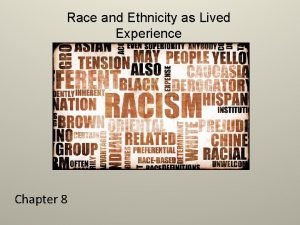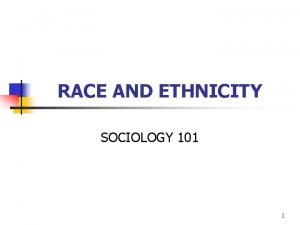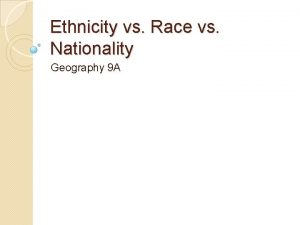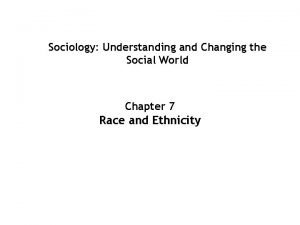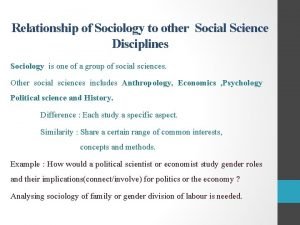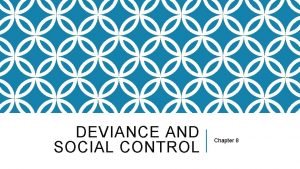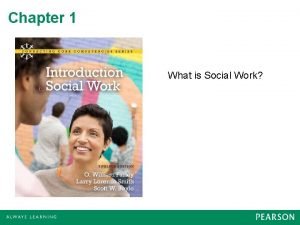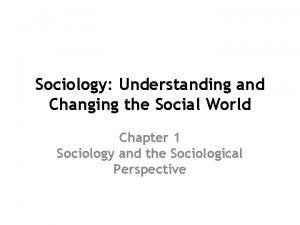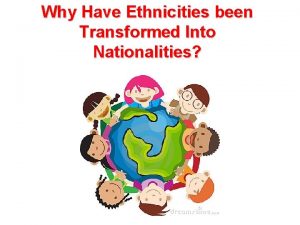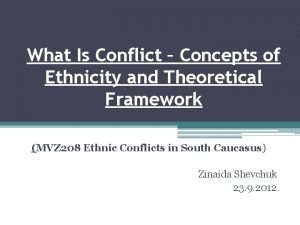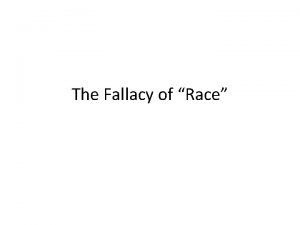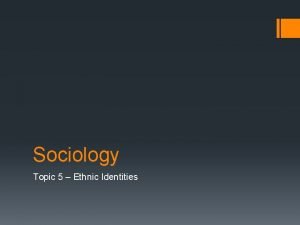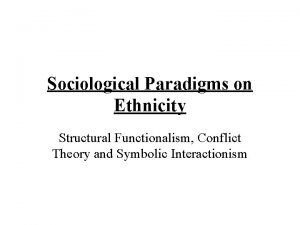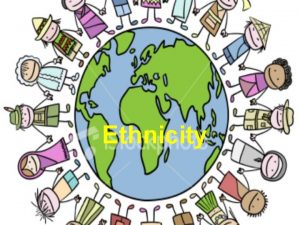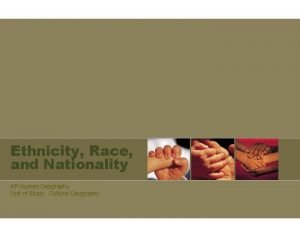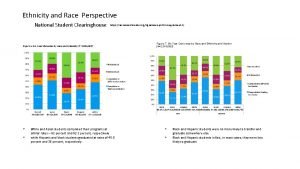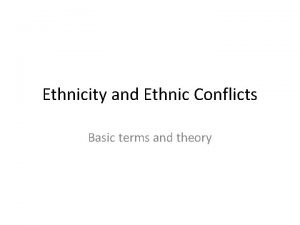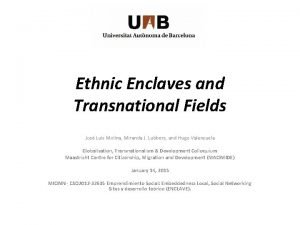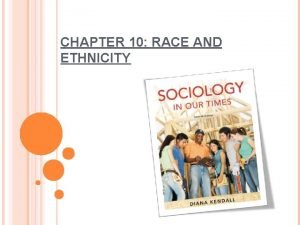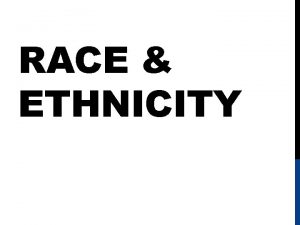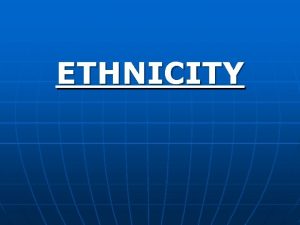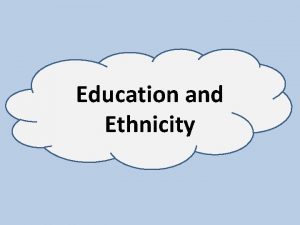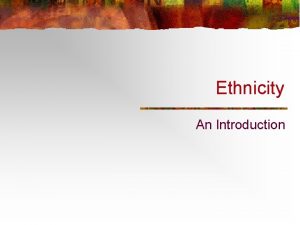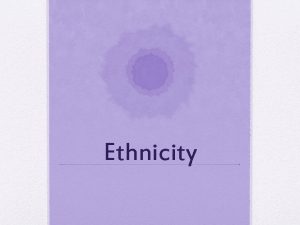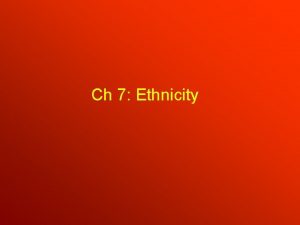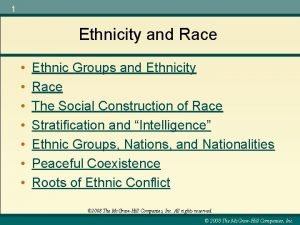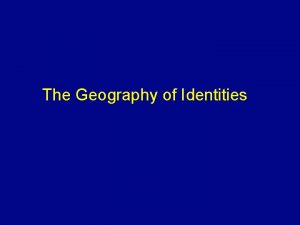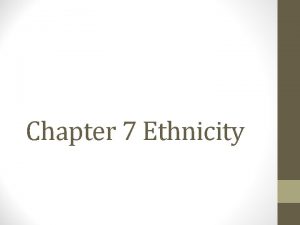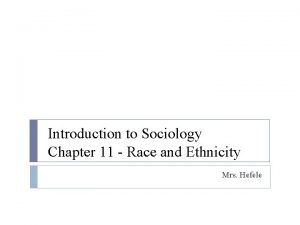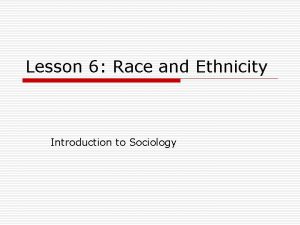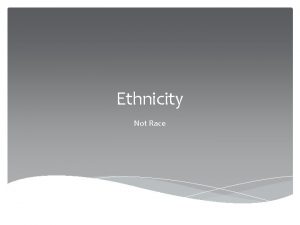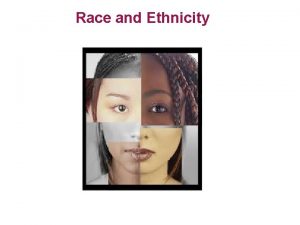Race and Ethnicity Introduction to Sociology Social Construction



































- Slides: 35

Race and Ethnicity Introduction to Sociology

Social Construction of Race is difficult to define. It is now more connected with physical characteristics, like skin tone, than with ancestral and family ties According to the social construction of race, race is not biologically identifiable. • Previous racial categories were arbitrarily assigned, based on pseudoscience, and used to justify racist practices • Racial categories change with time • Race doesn’t exist but racism does

What is Ethnicity? Ethnicity describes shared culture—the practices, values, and beliefs of a group. This culture might include shared language, religion, and traditions, among other commonalities

Minority Group • A minority or a subordinate group is “any group of people who, because of their physical or cultural characteristics, are singled out from the others in the society in which they live for differential and unequal treatment, and who therefore regard themselves as objects of collective discrimination. ” • The majority or dominant group is that which holds the most power in a given society

Characteristics of Minority Groups A minority group is distinguished by five characteristics: 1. unequal treatment and less power over their lives 2. distinguishing physical or cultural traits like skin color or language 3. involuntary membership in the group 4. awareness of subordination 5. high rate of in-group marriage

Scapegoat Theory • The dominant group will displace its unfocused aggression onto a subordinate group. • For example, in the United States and Europe, recent immigrants have frequently been the scapegoat for the nation’s—or an individual’s—woes

Racial Profiling Racial profiling—the use by law enforcement of race alone to determine whether to stop and detain someone

Differentiating between Prejudice, Stereotypes, and Discrimination • prejudice: biased thought based on flawed assumptions about a group of people • discrimination: prejudiced action against a group of people • stereotypes: oversimplified ideas about groups of people

Defining Racism • Racism: a set of attitudes, beliefs, and practices that are used to justify the belief that one racial category is somehow superior or inferior to others • Institutional racism: racism embedded in social institutions

Perpetuating Racial Inequality • sedimentation of racial inequality: the intergenerational impact of de facto and de jure racism that limits the abilities of black people to accumulate wealth • white privilege: the benefits people receive simply by being part of the dominant group

Racist Practices • racial steering: the act of real estate agents directing prospective homeowners toward or away from certain neighborhoods based on their race • redlining: the practice of routinely refusing mortgages for households and business located in predominately minority communities • racial profiling: the use by law enforcement of race alone to determine whether to stop and detain someone

Colorism is the belief that one type of skin tone is superior or inferior to another within a racial group

Multiple Identities Individuals with multiple ethnic backgrounds are becoming more common and people are increasingly able to embrace multiple identities

Functionalism: Why does Racism Persist? • Racism is functional for the dominant group, for example, suggesting that racism morally justifies a racially unequal society • Racism can strengthen bonds between in-groups members through the ostracism of out-group members • Dysfunctions associated with racism include the failure to take advantage of talent in the subjugated group, and that society must divert from other purposes the time and effort needed to maintain artificially constructed racial boundaries

Conflict Theory on Race and Ethnicity Conflict theorists focus on the past and current struggles between the white ruling class and racial and ethnic minorities, noting specific conflicts that have arisen when the dominant group perceived a threat from the minority group, such as: • Slavery • Jim Crow • disenfranchisement, with gerrymandering and voter suppression efforts aimed at predominantly minority neighborhoods

Intersection Theory It is impossible to separate the effects of race, class, gender, sexual orientation, and other attributes • How people experience race is shaped by gender and class • Multiple layers of disadvantage intersect to create the way we experience race

Symbolic Interactionism on Race and Ethnicity • Race and ethnicity provide strong symbols as sources of identity • How do people construct racial and ethnic identities?

Culture of prejudice is theory that prejudice is embedded in our culture

Intolerant Group Relations • expulsion: the act of a dominant group forcing a subordinate group to leave a certain area or even the country • genocide: the deliberate annihilation of a targeted group • segregation: the physical separation of two groups, particularly in residence, but also in workplace and social functions

Assimilation and Amalgamation • Assimilation is the process by which a minority individual or group takes on the characteristics of the dominant culture • Amalgamation is the process by which a minority group and a majority group combine to form a new group

Pluralism is a mixture of different cultures where each culture retains its own identity and yet adds to the whole

Native Americans • Before colonization Native Americans lived in an intricate web of hundreds of interconnected tribes, each with its own customs, traditions, languages, and religions • The effect of European settlement of the Americans was to nearly destroy the indigenous population through disease and exploitation

Practice Question To what extent is it helpful to consider Native American culture? To what extent should each tribe’s culture be considered individually?

U. S. Government’s War on Native Americans • The Indian Removal Act of 1930 forced the relocation of any native tribes east of the Mississippi River to lands west of the river • The Indian Appropriation Acts funded further removals and refused to recognize any Indian tribe as an independent nation, tribe, or power with which the U. S. government would have to make treaties • The Dawes Act of 1887 reversed the policy of isolating Native Americans on reservations, instead forcing them onto individual properties that were intermingled with white settlers, to reduce their capacity for power as a group • Children were forced to attend boarding schools where they were brutally treated and forced to assimilate

Contemporary Status Native Americans were able to participate in and benefit from the civil rights movement • The Indian Civil Rights Act of 1968 guaranteed Indian tribes most of the rights of the United States Bill of Rights • Indian Self-Determination Act of 1975 and the Education Assistance Act of the same year recognized tribal governments and gave them more power • Native American cultural groups are striving to preserve and maintain old traditions to keep them from being lost forever However, Native Americans still suffer the effects of degradation: • Long-term poverty, inadequate education, cultural dislocation, high rates of unemployment, and lower life expectancies than most groups in the United States

African Americans • Black Africans were kidnapped from their own lands and sold into slavery • Forced to endure whippings, executions, rapes, and violently separated from their families, they built this country

The Civil Rights Movement Boycotts, marches, sit-ins, and freedom rides succeeding in securing passage of the Civil Rights Act of 1964 which banned discrimination based on race, color, religion, sex, or national origin.

Current Status Although government-sponsored, formalized discrimination against African Americans has been outlawed, true equality does not yet exist. Scholars point to continuing and in some cases growing inequality with whites in the areas of: • unemployment • insurance coverage • incarceration • health, and education • income and wealth

Asian Americans • Asian Americans represent a great diversity of cultures and backgrounds • Faced discrimination: • Chinese Exclusion Act and Gentlemen’s Agreement excluding Japanese immigrants • Laws prohibiting land ownership by Japanese immigrants in California • Japanese internment in WWII • Model minority stereotypes today

Hispanic Americans • Hispanic Americans have a wide range of backgrounds and nationalities • Much of the land that is now the Southwest was part of Mexico until 1848 • Until 1986 many Mexican immigrants came to the U. S. to work for a few years and make more money then they would return to Mexico • The strengthening of the border that began with 1986’s Immigration Reform and Control Act has made one-way migration far more common • Because they were fleeing a communist country, Cubans were given refugee status • Many of the Cuban refugees were wealthy and educated

Hispanic Americans Today Hispanic Americans, especially those who are here illegally, are at the center of a national debate about immigration

Arab Americans • Not all Arabs are Muslim, and not all Muslims are Arab • People whose ancestry lies in the Middle East or who speak primarily Arabic may consider themselves Arabs • Many early Arab immigrants were Christians, and they came to escape persecution and to make a better life • Since 1965, more Arab immigrants are highly educated Muslims escaping political unrest and looking for better opportunities

Contemporary Challenges Stereotypes, profiling, and hate crimes affect many Arab. Americans

White Ethnic Americans • Irish and Southern and Eastern European immigrants faced discrimination • In the 20 th century they were able to assimilate into whiteness and benefit from the GI Bill and New Deal programs that expanded the middle class • They retain some ethic identity and practices

Quick Review • Define and differentiate between race, ethnicity, majority groups/minority groups, stereotypes, prejudice, and discrimination • Summarize the key ideas behind the three theoretical perspectives on racial inequality • Compare and contrast the experiences of ethnic groups in the United States
 Chapter 8: race and ethnicity as lived experience
Chapter 8: race and ethnicity as lived experience Definition of race and ethnicity
Definition of race and ethnicity Race vs ethnicity vs nationality
Race vs ethnicity vs nationality Mechanical efficiency of turbine
Mechanical efficiency of turbine Types of spillway
Types of spillway Data race vs race condition
Data race vs race condition Introduction to anthropology psychology and sociology
Introduction to anthropology psychology and sociology Venn diagram of psychology and sociology
Venn diagram of psychology and sociology Introduction to anthropology psychology and sociology
Introduction to anthropology psychology and sociology Sociology understanding and changing the social world
Sociology understanding and changing the social world Social science sociology
Social science sociology Primary deviance definition
Primary deviance definition Similarities between sociology and social work
Similarities between sociology and social work Debunking motif definition
Debunking motif definition Countries and nationalities
Countries and nationalities What is ethnicity
What is ethnicity Troian bellisario ethnicity
Troian bellisario ethnicity What is ethnicity
What is ethnicity Definition of structural functionalism
Definition of structural functionalism Symbolic ethnicity
Symbolic ethnicity Ethnicity in sociolinguistics
Ethnicity in sociolinguistics Lactose intolerance by country
Lactose intolerance by country The key elements of nationalism include all but
The key elements of nationalism include all but Ethnicity examples
Ethnicity examples Ethnicity definiton
Ethnicity definiton Ethnicity in postcolonialism
Ethnicity in postcolonialism Whats ethnicity mean
Whats ethnicity mean Baltic finnic ethnic group
Baltic finnic ethnic group Taylor swift ethnicity
Taylor swift ethnicity Avian ku ethnicity
Avian ku ethnicity Blood type genetics
Blood type genetics Bitwit ethnicity
Bitwit ethnicity Is hispanic an ethnicity
Is hispanic an ethnicity Servingness
Servingness Luis molina ethnicity
Luis molina ethnicity Tower hamlets ethnicity
Tower hamlets ethnicity
